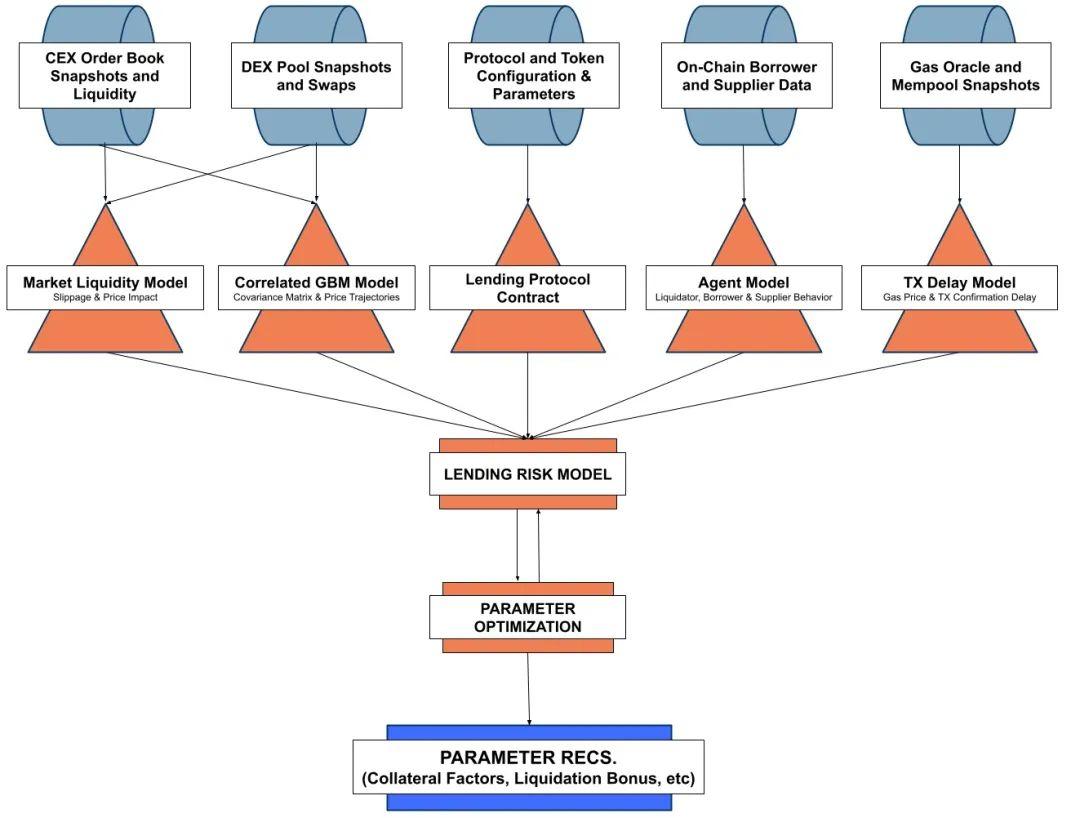Detailed Explanation of DeFi Risk Management Tool Gauntlet: How to Reduce DeFi Risks and Improve Capital Efficiency through Risk Parameterization?
Author: Beichen, Chain Tea House
Finance is constantly dealing with risks: credit risk, liquidity risk, portfolio risk, trading risk…
In traditional financial markets, these risks are hidden behind countless large institutions, managed by professional teams of hundreds or thousands of people, which can effectively address (or transfer) the risks faced by their respective institutions. However, this can also accumulate into systemic financial crises, ultimately resulting in everyone bearing the cost (more accurately, taking the hit).
Decentralized finance (DeFi) lacks financial institutions; the entire DeFi market is composed of countless open protocols, thus the turbulence and uncertainty are dispersed among these protocols or their traders. They all need financial risk management tools to cope with the increasingly complex market and hackers.
The uniqueness of the DeFi market lies in its reconstruction of various financial products using crypto logic, so traditional financial market risk management tools cannot be directly applied. Instead, it requires individuals who are sufficiently knowledgeable in both finance and DeFi to design a completely new framework to help protocols or traders make better decisions.
Recently, the DeFi risk simulation platform Gauntlet raised $23.8 million at a valuation of $1 billion, as it is one of the few formal players in this field.
Parameterizing Risk
First, it is important to emphasize that financial risk management is not about avoiding risk— that is called insurance.
For finance, the other side of risk is capital efficiency. Financial risk management aims to maximize returns for investors while keeping risks under control.
For example, Gauntlet can double the LP income of Balancer, increase the liquidity mining efficiency of SushiSwap by five times, help Aave avoid the liquidation spiral caused by market crashes, and enable Compound to lend out more assets…
And all of this is based on the premise that risk has not increased.
The basic principle is to parameterize the risks of DeFi protocols and then place these key parameters into Gauntlet's risk assessment framework for intuitive monitoring and dynamic risk measurement.
It is worth mentioning that each protocol corresponds to a specific risk assessment framework, which requires the research team behind it to perform financial modeling and adjust these parameters based on data simulations.
To parameterize the risk of a DeFi protocol, the following processes need to be carried out:
Capture the key data of the protocol—such as market data, borrower data, and core liquidity data.
First, calculate the risks and capital efficiency indicated by the above data using common risk parameters (such as collateral ratio, liquidation threshold, liquidation bonus, reserve factor, etc.).
Begin simulating key data under various scenarios to derive the objective function for maximizing risk capture and capital efficiency, as well as determining the relevant parameters.
Data scientists start manually optimizing parameters, mainly to ensure that the system does not recommend outrageous suggestions.
After completing the above processes, one can clearly understand the market performance of this DeFi protocol under different circumstances, naturally leading to a clear understanding of what actions are most reasonable—whether maximizing profits or avoiding collapse.
Of course, before starting the entire process mentioned above, the Gauntlet team needs to have a sufficiently deep understanding of this DeFi protocol. More detailed introductions will follow.

Currently, Gauntlet provides risk management services for DeFi protocols such as Aave, Compound, BenQi, Acala, Parallel, Synthetix, and SushiSwap.
SushiSwap: Liquidity Has Not Decreased, But Liquidity Incentives Have Increased by Five Times
The liquidity incentives promoted by Compound directly initiated DeFi Summer, with countless people rushing in to earn extra COMP incentives, repeatedly borrowing and lending.
Now, the founding teams of DeFi protocols can only lament how cheap the traffic was back then, as liquidity incentives have almost become a heavy burden for all DeFi protocols.
If liquidity incentives are high enough, user numbers and TVL can be quickly boosted. Once liquidity incentives are stopped or even reduced, these will flow away.
Over the past two years, we have seen too many ephemeral DeFi protocols rise due to liquidity incentives and then fall because of them.
In fact, for project parties, there is another option in the choice of whether to implement liquidity incentives—precise incentives.
We can intuitively understand this through the risk management services provided by Gauntlet for SushiSwap.
In May 2021, SushiSwap launched the second round of its liquidity incentive program Onsen, aiming to direct liquidity to non-mainstream liquidity pools.
Simple and crude rewards have become increasingly inefficient and difficult to convert into long-term liquidity and trading volume. Therefore, the SushiSwap team needs to know what the optimal incentive amount is and which liquidity pools are most deserving of rewards.
Gauntlet provided an incentive optimization solution through modeling.
First, according to the previously mentioned process, it calculated the baseline for liquidity incentives across the entire DeFi space. If the returns fall below this baseline, there will not be much liquidity coming in, and existing liquidity may even flow out.
Then, based on the historical data of each liquidity pool, it conducted statistical modeling on "the impact of incentive changes on capital inflows/outflows of liquidity pools," allowing for a clear view of which liquidity pool's LPs do not care about liquidity incentives and which pool reacts most strongly, thereby maximizing the impact of incentives.
In colloquial terms—adjusting the dish according to the diner.
For example, Gauntlet found that the LPs of SushiSwap's YFI-ETH pool are primarily savings-driven and do not care much about liquidity incentives. Therefore, SushiSwap reduced the incentives for this pool by 75% over three months, but liquidity did not decrease significantly; instead, it continued to increase…
Based on Sushi's price at the time, this saved SushiSwap about $22.4 million, and the saved Sushi would be allocated to more sensitive pools, such as the RGT-ETH pool.
The final result was that the amount of incentive tokens for SushiSwap did not increase, but daily trading volume increased by $300 million. Because each incentivized Sushi token could attract $10,000 in liquidity, whereas previously it could only attract $2,000. This means the effectiveness of the incentives increased by five times.
Compound: Risk Remains the Same, But More Money Can Be Lent Out
Compared to traditional finance, the decentralized lending platform Compound is a minimalist platform, allowing both lenders and borrowers to complete transactions in a minute.
The only risk is a sharp decline in the value of collateral assets, triggering automatic liquidation.
The traditional avoidance method is to provide more collateral (for example, $500 in collateral for $100 in debt) or to borrow less (for example, borrowing only $30 against $100 in collateral), but this is not capital efficient.
Gauntlet provided a solution. It first identified several key factors leading to liquidation: user behavior, collateral volatility, relative collateral liquidity, protocol parameters, and smart contract risk. The first four factors determine the likelihood of liquidation, while smart contract risk is not counted.
Next, it analyzed the historical liquidity and volatility data of different collateral types on Compound, identifying those that are commonly used but have unstable prices. It modeled this data in conjunction with gas costs, the number of liquidator addresses, platform reserves, etc., to monitor potential risks in real-time.
For ordinary users, this allows for flexible borrowing and lending under controlled risk.
More importantly, lending platforms no longer need to liquidate in a one-size-fits-all manner, as sometimes market fluctuations are very short-term and the actual risk is not high.
In addition to providing this service to Compound, Gauntlet also collaborates with platforms like Aave and Maker.
The result of the services provided by Gauntlet is that even when some collateral assets plummet by more than 50%, users do not experience any significant bankruptcies.
Conclusion
The above two cases are just a starting point; Gauntlet provides customized risk management services for many leading DeFi protocols, involving extensive research in financial modeling.
At this stage, Gauntlet is more focused on collaborating with DeFi protocols to optimize risk management and capital efficiency at the product level.
In the long run, risk management tools are foundational settings for DeFi, needed not only by each protocol but also by every trader.
"Our platform consists of various predictive models, which we use to calibrate and improve the risk management and incentive measures of various DeFi protocols.
We are optimistic about Gauntlet's development in the long term, not only because of its existing achievements but also because if their parameters and models continue to improve, it will undoubtedly create a high barrier for competitors entering the market later.









